I’m Larsen Halleck, and I have a question for you: What if there was an exercise that could heal spinal pain, rejuvenate vertebral discs, add definition and size to muscles most people don’t even know exist, tone the arms and legs, strengthen the toes and ankles, expand lung capacity, and promote circulation?
And, what if variations of this same mythical exercise strengthen the neck, literally making you more difficult to punch out? The answer is: there is one, and it is one of the oldest exercises documented in human cultures: the bridge.
As Yogic Pose And Healing Method
Many ancient peoples, such as those of the Indian Subcontinent were well versed in this exercise. From this book:
“…Strengthens back muscles, tones adrenals, helps kidneys, front part of the body is being stretch entirely, which…may work on their heart chakra…The muscles on the front part of the thighs are stretched and the calves are strengthened while doing and holding the pose… This pose is extremely beneficial for those who sit long hours. The backward bend in the pose relieves tension or stress from the body and help in decreasing the ailments arising out of it. This pose will also help in toning and strengthening the back”
While I have my doubts about some of these claims, I can personally vouch for the usefulness of the bridge for pain relief, as well as strengthening the back and shoulders.
I mastered bridging when I was in my sophomore year of college, at a time when I had never once attempted to deadlift. A year or two later, when I no longer bridged and started to deadlift, I lifted with horrible form, as most people do when they first attempt that exercise. It took me about two months to realize that I was getting persistent lower back pain.
Once I began to bridge again, it took the edge off my back pain. Once I shored up my form, continuing to do rounds of bridging afterwards, I have literally never had any back pain from deadlifting again, and in that timespan I have gone from deadlifting 95 pounds to deadlifting 350 pounds.
Many lifters complain about throwing their backs out, having herniated vertebral discs, and other spinal suffering, but these are fates I have completely avoided, which I attribute to bridging. As a side benefit, bridging gave me these (literally and figuratively) groovy erector spinae muscles snaking up the middle of my back a defined muscle that you will rarely see at the gym.
And needless to say, women find a man that can bend backwards and touch the ground to be mighty sexy.
There’s more benefits to bridging, such as…
Combat Sports, Martial Arts, And General Athletics
“How does this fruity yoga shit help me kick a dude’s ass?!” you might be asking. Plenty of ways…most of which are defensive and preventative in nature.
Many grappling arts, such as wrestling, judo, jiu-jitsu (both traditional and Brazilian), shua jiao, mixed martial arts, etc. extensively bridge, predominantly for escaping pinfalls, extricating oneself from a mounted position, and maneuvering yourself to positions of superiority.
Neck bridging (discussed below) has a more direct application to combat: strengthening your neck keeps your head from flopping around and thus getting concussed (it’s the brain slamming into the inside of the skull that knocks you out, and the neck essentially acts as a lever-a stronger neck means less movement of the lever.) In addition, making your neck stronger gives you a harder headbutt. Training to hold neck bridges for long periods of time trains your mental fortitude as well.
In terms of general athleticism, anybody that is capable of proper-form kip-ups or back handsprings is by definition athletic, and increased explosiveness and coordination won’t hurt your athletic endeavors, whatever they may be.
Learning To Bridge
“I need to learn how to bridge!” you might be saying, “But I’ve never been taught how!”
One of the most damning criticisms I can give to modern fitness training is just stating that nobody bridges, despite the fact that so many ailments of modernity can be solved with regular bridging. Allow me, your knight in “spining” armor, to teach you.
The first bridge you’ll be doing is the static bridge. Lay down on the floor on your back. Put your feet flat with your knees up. Put your hands flat, palm down, near your temples. Now, simultaneously thrust the hips up as you push down on the floor with your hands and feet. Allow your head to go back between your shoulders.
A proper bridge has 4 components: 1) Arms and legs as straight as possible, 2) Arch in the back, 3) Head tilted back in a relaxed position, and 4) Breathing is natural and deep.
If you are incapable of doing a bridge in your first go (most people can’t), then begin with short bridges-laying down, crossing your arms over your chest, and then pushing the legs and hips up without moving the arms.
Once you have mastered that (holding it 10+ seconds) do half bridges. Get in the bridge position, then roll a basketball or soccer ball under your lumbar vertebrae. Then push off the ground just like the true bridge, but it’s easier because you don’t have to lift off all the way from the floor. Once this is mastered, attempt the static bridge again.
When the static bridge is done, work on active bridges. The first of these is the downward wall walk: Stand with your back to a wall, and bend back until your hands touch the wall (palms down, naturally). Then “walk” down the wall on your hands, slowly bending the legs and occasionally stepping forward if needed. If you can’t walk down all the way, go down as far as you can, then stop. Do not twist the back, keep it oriented properly.
Once you accomplish that, walk up the wall.
Next step is an active bridge without the wall-stand up, put your hands on your hips and your feet shoulder width apart. Get on the balls of your feet, thrust the hips forward, and bend back, until you see the floor behind you. Continue bending and place your hands on the floor. Land gently.
And finally, you’re going to stand up from a bridge position-press down hard with both your hands and the balls of your feet, shift the weight forward, and stand yourself up. It’s kind of hard to describe, but it is a highly distinctive feeling. Again, avoid twisting the torso.
From here, you can begin learning back handsprings and kip-ups. But as a word of advice, you will not be capable of doing those without complete mastery of bridging. Work on the steps I’ve given above, and do them to end your day of resistance training.
Neck Bridging
Neck bridging has less variations, but is more painful than standard bridging. As the name implies, the weight is borne entirely on the neck.
You will likely not be able to do neck bridging your first try, so do headstands instead. Then gradually remove your hands from the headstand (ie: remove one hand first, then the other later), and you will have the neckstand. Once you can hold a neckstand for at least 10 seconds, you can try the neck bridge.
Lay down in the standard bridge position, but with your hands off the floor (I put them across my chest). Then, put pressure down on the head and roll back, bearing all the weight upon your scalp and feet (your forehead should almost be touching the floor). Flex the neck muscles to make sure your head goes straight back, and from here you can either hold for time or do repetitions (ie: roll back to the starting position, and then to the bridge position again, keeping the head aligned and straight).
Conclusion
My suspicion is that if people did 20-30 minutes of bridging just one day a week, back maladies would be halved, no matter how many hours you spend sitting over a computer. Increased mobility, flexibility, endurance, and sex appeal—what other reasons do you need to bridge?
Read More: The Single Most Effective Exercise Any Man Can Do
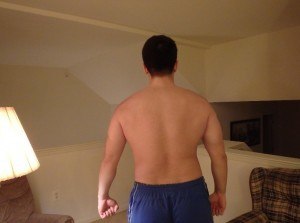
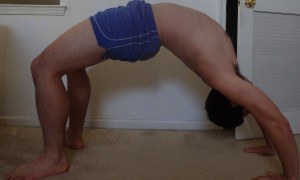
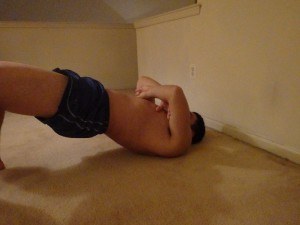
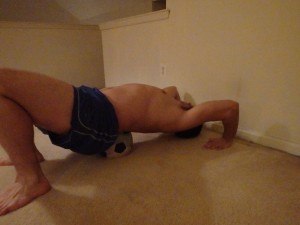
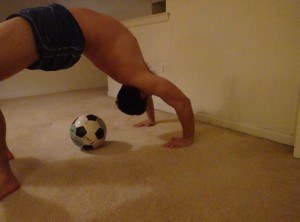
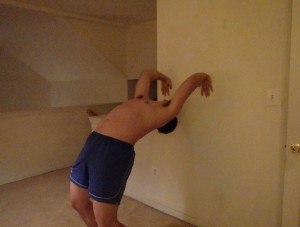
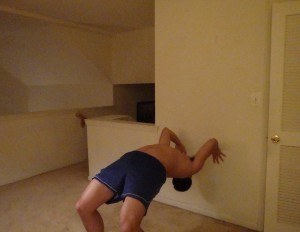
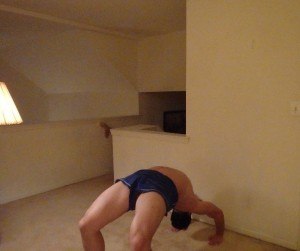
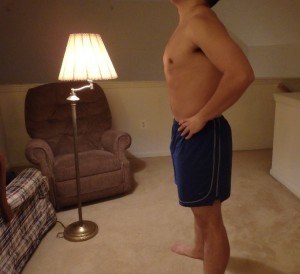
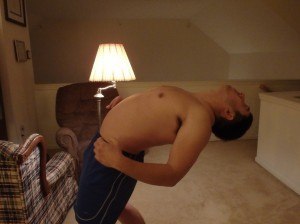
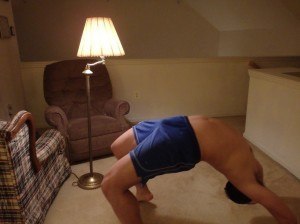
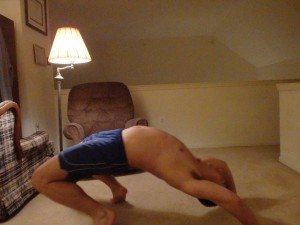
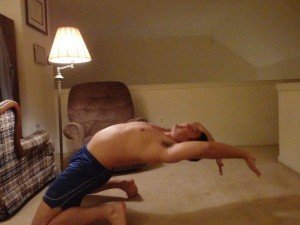
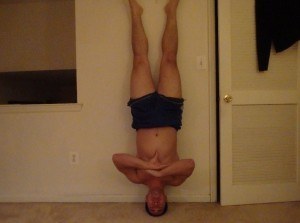
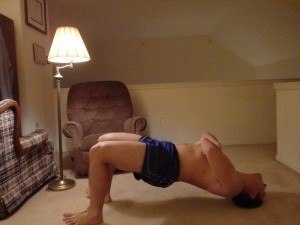
I can attest to the value of the back bridge. Nowadays, we are typically hunched forward in a near fetal position most of the day (think driving, sitting at a desk, etc). Our bodies begin to tighten and set in that position which causes tons of posture problems. I really need to get back into doing these regularly. Great article!
I used to do these regularly as part of exercise class in college, but without knowing *WHY* I didn’t give them the emphasis they deserve. Going to add them back to the lineup.
Between that and the stomach vacuums, your core will be beastly.
I’ve never had my stomach vacuumed but it sounds unpleasant.
Another great exercise to keep your back straight is barbell rows. Keep your lats tight or you’ll turn into a hunchback.
…
I am not an animal!
That is a nice sofa.
http://i3.kym-cdn.com/photos/images/list/000/621/106/d22.jpg
That one looks familiar. IKEA?
Backroom Casting Couch.
It was a rhetorical question.
So was his answer I think.
What is that, a picture for ants?
I grew up doing martial arts and a bit of gymnastics. I was a weakling in many ways, but this stuff was second nature. I often took people off guard, as my core strength far out shined my arm and leg strength. Later, I bulked up my arm and leg strength, but still kept much of the flexibility and core strength i had developed when I was young.
I was reckless about a decade back and did a random head stand on a soft surface (my bed) and compressed/damaged a vertebrae in my neck. I weighed about 225 at the time, far more than the 170 or so I weighed when I was a nimble martial artist. Anyways, work slowly to build up your neck strength. Start with tripod (? where your legs rest on your elbows) head stands, than regular ones, and be very comfortable with lots of weight on your neck before you do a no arms head stand. And remember, just because something was second nature when you were young doesn’t mean you body is capable of it now. I ripped some leg muscles pretty bad showing off high kicks one time when I was drunk and not currently in a kicking regime. It never fully healed right, as scar tissue just isn’t stretchy at all. Know your limits.
Definitely will incorporate this, Looks very relieving.
Co-signed on the article. Started full bridging (off the floor) & wall walking bridges almost 2 years ago. Cured over time whatever lower back issues I was having in my twenties from poor posture & inflexibility & continuous hiking expeditions. Using a variation of the neck bridge for almost a year now. Definitely an added benefit for the neck muscles & avoiding a sore neck. I relied on the Convict Conditioning (Paul Wade) approach with developing the bridge progressions.
You still have to be careful with bridging if you have lower back issues.
True. I think deep bodyweight squats (heels flat on the ground, hamstrings touching calves) have helped massively towards having a healthier lower back as well.
How is that book, btw?
Worth it if you’re at a beginner level or if you’ve hit a rut with with non bodyweight specific workouts. I’ve moved on to other approaches as I’ve gotten better over time. But I come back to a few of the programs from time to time. A worthy investment I’d say. Along with Convict Conditioning 2, the second book.
I can kip up but wanted some training for back springs. Thanks bro.
Explosive Calisthenics.
Its more of a flexibility problem at the moment. My front back and side flips are all decent.
Try some mobility work, see if that helps.
It’s interesting how the Indians were home to so much wisdom, the Vedic texts, the lessons of Yoga, the references to the bridge discussed above, the variety of spices that are powerful antioxidants with anti-inflammatory properties (turmeric, fennel, cloves, etc.) and yet when I think of a modern Indian, I do not thing of a strong, powerful man. I know very little of Indian history, but I don’t know of a period where they were a particularly powerful or influential group.
I love Indian food, and always feel healthy after a good meal. I know white American guys in their 60s who practice yoga and they are tough as nails. Yet, I have a real problem picturing a powerful Indian man. I don’t know the explanation, but it’s an interesting discrepancy.
Indians, like many men of Asian cultures, have somehow lost that masculine edge. I don’t know if it’s a media perception thing but it seems to be that way. Same thing with the Chinese too. When I was in Beijing, there might as well have been a masculinity drought.
That’s because all the hard men were killed in war. These would have been the ones who resisted the British. Only the pussies remain.
Thanks. We need more articles like this.
I replaced these with pull ups but you are right. I’m going to add them back in tommorow. Also I’m jealous of your neck stand . I could only do one with a pillow
Yeah you definitely want to be doing both.
“Many ancient peoples, such as those of the Indian Subcontinent were well versed in this exercise. From this book:
““…tones adrenals”
In gymnastics they teach the bridge right from the beginning, as early as age three, so as to proceed to the back-walkover and then back handspring.
The goal in Yoga is really messing with the adrenal glands to throw the hormone system out of whack in way that inclines a person to the Hindu/Eastern/New-Age/feminist/vegan/slave type mindset and spirituality that is the directly opposed to Orthodox Christianity (which is true center of Western Civ).
Could you please elaborate on the effects of messing with the adrenal glands in yoga.
I know that non meat diets is often promoted by sects since it helps mind control when the brain is nutrient deficient, i have a hunch it effects the endocrine system negatively as well.
“Could you please elaborate on the effects of messing with the adrenal glands in yoga.”
http://www.holycrossyakima.org/orthodoxPdfs/YOGA%20Leaflet.pdf
“I know that non meat diets is often promoted by sects since it helps mind control when the brain is nutrient deficient,”
1 Timothy 4:3
“Forbidding to marry, and commanding to abstain from meats, which God hath created to be received with thanksgiving of them which believe and know the truth.”
Thanks.
pretty sure “meat” just meant “food” in the early modern english of the KJV. a quick google search shows “foods” in that verse in more modern translations. “flesh” (like the german “fleisch”) would have been the word for meat in earlier forms of english, IIRC.
Did you know that bridging is part of the Jewish Conspiracy to make us all Jewish?
“Did you know that bridging is part of the Jewish Conspiracy to make us all Jewish?”
It isn’t the bridge; it is why they are doing the bridge, how long they are holding it, and the whole system of exercises that it is part of and what their combined result is.
I searched for “yoga adrenal glands” and got 211,000 hits.
The bridge is great when it is part of a western system of exercise like gymnastics:
The goal of gymnastics is producing men with active minds and warrior bodies which meshes with Orthodoxy well.
Hinduism and Yoga produces India, a racial pyramid (caste system) disguised as a religion, that the Aryan conquerors created to control and keep passive the conquered. Empty your mind, do your dharma to get good karma so you can come back in the next life as a member of a higher caste, don’t eat meat, do these awkward Yoga positions that will help you empty your mind.
If only you could teach the mentality. Pursue freedom of movement and the ability to move in any way like a baby learns to crawl. Most people can’t even hold their leg above the hips for 2 seconds. Those muscles are clutch for keeping your low back and posture strong, but most people never use them and so when learning you literally have start from the beginning i.e. crawl walk run. Takes years, but most people never master their own bodies and so the benefits are lost on most.
No thanks. I think I’ll just keep deadlifting.
Yeah. And keep strengthening your muscle, not just fine tuning your neuro-muscular coordination.
Bodyweight training vs. true resistance training, age old struggle.
To be fair, the author deadlifts too.
Bodyweight training is the king of training. It is the basis. You can add weight-training once you have mastered your body.
Bob, I say “Bullshit!” to you…..Whattya got? Let’s hear it.
I’m going to smack you in the face with a 45 plate!
So you can pick up a 45 pound plate? All those wall pushups must be working well for you.
LOL… indeed they do.
Im going to need to get some kratom for this…
I can vouch for neck bridging, I had nasty recurring headaches and neck aches from an old injury and five minutes of neck bridging per day fixed it almost instantly
The fuck is this?
I have been doing bridging for years. Frankly, I think if you bridge you can dispense with dead-lifts. In fact, everyone I know who dead-lifts suffers some kind of lower back problem.
It definitely gets you noticed in the gym and yes I can confirm that women find it sexy.
I never paid much attention to that excercise until I was submitted every time in judo matches
……………………..
I wouldn’t recommend doing the neckstand until you’re used to the basics.
I hated those things in wrestling. We did them to death. But yes we all need to spend for more time on our trunks. But that is not where the pretty muscles are. These are just muscles that keep you from getting hurt. And the ones that actually make you strong. You are only as strong as your weakest link
I don’t know, rolling around and wrestling with some sweaty guy. Seems kinda gay…
Why is your weak ass giving anyone tips on exercise? That neck stand is just asking for injury.
I see the football players doing the neck bridging, helmets on. Makes sense given the piles and contortions they’re forced into.
Great article. Will definitely give it a try. Thanks.